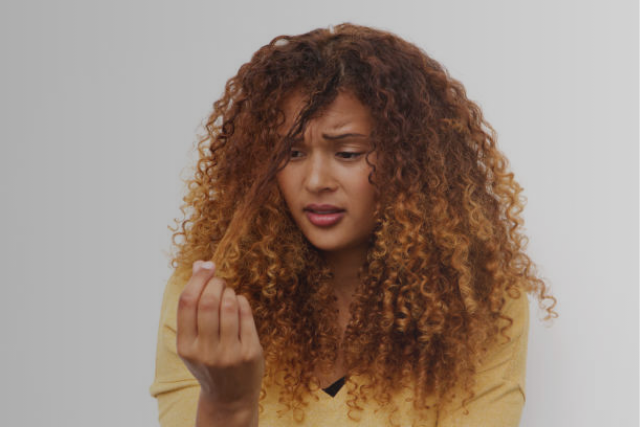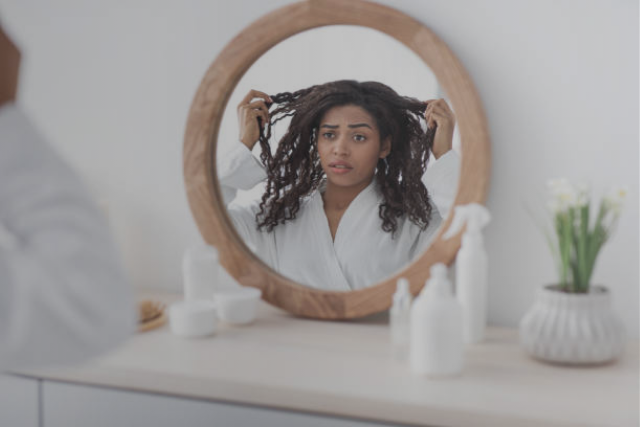Low-porosity hair requires special care to sustain its health and vitality. Many people with low-porosity hair struggle to find a good routine, and they often experience product buildup, dryness, or irritation.
You’ve come to the right place if this sounds all too familiar. Below is a blog on understanding and identifying low porosity hair, care, and how to make the most of a hair care routine.
What Does Low Porosity Hair Mean?
Have you ever wondered what is low porosity hair? If so, then this comprehensive guide will help you understand all you need to know about low porosity hair.

Hair is made up of dead cells arranged in three well-defined layers:
- Cuticle: The outermost layer is composed of overlapping cuticle cells.
- Cortex: The thick middle layer provides strength through fibrous proteins.
- Medulla: The innermost core of the hair shaft.
In low-porosity hair, the cuticles are tightly packed and partially overlapped. Thus, creating a barrier through which water and hair products like oils and conditioners cannot penetrate the hair shaft.
Key characteristics of low porosity hair include:
- Water Beads Up: Instead of soaking into the strands, water forms beads on the surface.
- Product Buildup: Styling creams, oils, and conditioners just rest on top rather than getting absorbed.
- Persistent Dryness: Hair may be dry and brittle regardless of how much it is moisturized.
What are the Characteristics of Low Porosity Hair?
Low porosity hair is defined by several specific characteristics. These particular traits are direct results of how the tightly closed cuticle layer affects the hair. The characteristics include the way the hair receives and releases moisture, product, and environmental elements.
Being able to identify these characteristics will help you further understand your hair. You can take care of your hair without feeling frustrated or wasting time and money on products that aren’t right for it.
Common Features:
- Shiny Appearance: The sealed cuticle reflects light, giving hair a natural, shiny aspect.
- Slow Drying Time: The hair takes much longer to air dry because the water has a hard time penetrating and evaporating.
- Product Build-Up: Heavier creams, oils, and conditioners often sit on the surface, creating oiliness or residue.
- Resistance to Chemical Treatments: Hair can become resistant to coloring, perming, or other treatments as the cuticle is not willing to open.
All these characteristics require special care. For example, light, water-based products and techniques can improve moisture penetration. This way your hair remains healthy, soft, and manageable.
What causes hair to have low porosity?
Low porosity is generally caused by natural genetic backgrounds. However, it may also partially depend on external factors. Let’s discuss the possible causes of low porosity hair.
Possible Causes:
- Genetics: Most people have low porosity hair because of the cuticle structure that is more tightly closed, a natural trait of the hair.
- Using Too Many Proteins: Too many treatments or products containing protein, such as keratin masks and conditioners enriched with protein, make low porosity increase. This is because the cuticle starts acting too stiff or sealed.
- Product Buildup: The heavy use of silicones, mineral oils, and waxes in hair products may build up. This gives an appearance of low porosity hair because the hair shaft cannot take up moisture.
- Heat Damage or Environmental Factors: Though it doesn’t happen that often, over time, heat and polluting agents break the cuticle layer of the hair. Hence, making it more resistant.
By identifying the cause, you can make conscious changes to your routine.
How to Test for Hair Porosity?
Understanding your hair’s porosity is a key starting point toward crafting a well-targeted hair care routine. Testing the porosity of your hair is not exactly complicated, doesn’t require much equipment, and can even be done right at home.
These tests help determine how well your hair absorbs or retains moisture. This will guide you toward appropriate products and methods.
The Float Test:
This is one of the most accessible and popular ways to measure hair porosity.
Steps:
- Take a clean strand of hair, ensuring it’s free of oils, conditioners, or other products to avoid skewed results.
- Fill a glass with water at room temperature.
- Place the strand on the surface of the water gently.
- Observe the behavior of the strand:
- Floats: Indicates low porosity, as the cuticle is tightly sealed and resists water absorption.
- Sinks slowly: Represents medium, or normal, porosity, where water is absorbed through the cuticle at a balanced rate.
- Sinks quickly: Indicates high porosity, where the cuticle is open or damaged, allowing it to absorb water readily.
The Spray Test
This test helps determine hair porosity by observing how water interacts with your hair when misted.
Steps:
- Take a small section of clean, dry hair.
- Mist water evenly over the section using a spray bottle.
Observe the water’s behavior:
- Beads up and sits on the surface: Low porosity, as the cuticle repels water.
- Absorbs after a few seconds: Medium porosity.
- Absorbs instantly: High porosity, indicating the cuticle is open and porous.
This test is simple and doesn’t require removing strands of hair. This makes it a quick and convenient assessment.
The Slip-and-Slide Test
This method evaluates the texture and structure of your hair strands by touch.
Steps:
- Take a single strand of hair and hold it between your fingers.
- Slide your fingers along the strand, from the tip to the root.
- Notice the texture:
- Smooth: Low porosity, with a tightly sealed cuticle creating a uniform surface.
- Slightly bumpy: Medium porosity, where the cuticle is slightly raised.
Very bumpy or rough: High porosity, indicating a raised or damaged cuticle.
What are the Challenges of Low Porosity Hair?
Low porosity hair is challenging in itself because of its sealed, tight cuticle structure. Although this structure serves for protection, it can hamper the hair from drawing adequate moisture and nutrients for hair health. This more likely results in dryness and buildup.

Here are the key challenges:
Moisture Retention
Hydration is quite a challenge because water as well as hydrating products struggle to penetrate the cuticle.
Hair may look dehydrated or break even after applying moisturizing products.
Product Absorption
Oils, creams, and conditioners often stay on the surface rather than penetrating the hair.
This can cause the hair to feel weighed down, greasy, or both.
Scalp Problems
Product buildup occurs as a result of ineffective penetration, causing pores to be clogged, flakes to develop, itchiness, or an unhealthy scalp environment.
Styling Defiance
Chemical treatments or styling products may not penetrate the hair easily. This makes it hard to get the look.
Tips for avoiding these issues:
-
Use heat, such as warm water, steam, or heated caps. This helps open the cuticle to let products penetrate.
-
Use light, water-based formulas that the hair finds easier to absorb.
-
Use clarifying shampoos, which can reduce buildup and keep the scalp healthy.
-
Avoid heavy oils and butter that may sit on the surface.
With proper approach and regular care, all these problems become tolerable.
Best Practices for Low Porosity Hair Care
Managing low-porosity hair requires consistency in a routine. Low porosity hair care generally builds up instead of moisturizing. This necessitates very specific care so that your hair stays healthy, moist, and manageable. Best practices specific to this type of hair make all the difference. Here are the top tips:
Use Heat
Adding heat to your routine will help loosen up the tight seal of the cuticle so that products may penetrate it. This can be done by using a hair steamer or applying a warm towel during deep conditioning.
Apply light products
Use water-based and lightweight formulas so that the hair will absorb better. Opt for labels with “hydrating” or “moisturizing,” and avoid heavy oils and silicones that weigh the hair down.
Clarify Regularly
Product buildup from styling products, oils, and conditioners makes low porosity hair even harder to hydrate. Use a sulfate-free clarifying shampoo once a month to remove residue and refresh your hair.
Use Steam Treatments
Steam sessions help lift the cuticle slightly for deep conditioning or treatments penetrating the hair strands from the inside.
Be consistent. Stick to a routine with regular moisturizing, cleansing, and deep conditioning. Being consistent is about being regular. This way your hair maintains its maximum hydration and health while avoiding long-term damage.
If you become consistent in this, common low-porosity hair difficulties can be faced. But you will develop a healthy, shiny, and easy-to-control hair care routine.
How to Correctly Moisturize Low Porosity Hair?
You have to use a specific hair care approach for low porosity hair as they can’t easily absorb water or hair care products. Plus, low-porosity hair has tightly closed cuticles. This makes them resistant to moisture penetration.
It is important to apply methods that can ‘prime’ the cuticle so that moisturizing agents can soak into the hair shafts. Here are some methods:
Pre-Treat with Apple Cider Vinegar Rinses
Use a diluted apple cider vinegar rinse (1 part vinegar to 4 parts water) before moisturizing. It helps to gently lift the cuticle, clarify the hair, and make it more receptive to moisture and conditioning treatments.
Use Hydrating Mists
Between washes, use a lightweight, water-based hydrating mist. It can refresh and add moisture without weighing down the hair. Look for mists with aloe vera and rose water.
Try Hot Oil Treatments
Warm a lightweight oil, such as argan or grapeseed oil. Apply it to damp hair. Cover with a shower cap and apply heat (using a towel or dryer). This will allow the oil to penetrate the cuticles, sealing in moisture and preventing dryness.
Without the right strategies, even the most intensive treatments may leave the hair appearing dry or lacking the benefits of moisture. Therefore, understanding how to properly prepare and treat low porosity hair is essential for achieving a healthy, hydrated look.
Effective Techniques for Low-Porosity Hair Care Routine
Here are some effective techniques for managing a low-porosity hair care routine:
Steam Treatments
Applying a hair steamer or the natural steam from a hot shower assists in the cutting of the cuticle. This allows for hair shaft penetration by moisture. Applying steam during the deep conditioning treatments has added advantages. It helps with the penetration of the product much better.
Layering
Try the LOC (Liquid Oil Cream) method beginning with a leave-in conditioner that is water-based to moisturize the hair strands. Treat it with a lighter oil such as argon or grapeseed oil to retain the moisture followed by using a light skin cream.
Hydrating Masks
Use the moisturizing masks at least once a week. Products with ingredients like glycerin or aloe vera gel help your hair hold moisture resulting in soft nourished hair. Use heat and steam to increase their implications.
Also, apply a hydrating mist on your hair every day. Also, avoid the application of hair products that weigh your hair down. These methods make your hair moistened, soft, and easy to comb.
Which Ingredients Should Be Avoided in Low Porosity Hair Care?

Low porosity hair is unique and using the wrong products only makes it worse. Many of these chemicals used in hair products lead to accumulation, inhibit the absorption of moisture, or even remove sebum from hair. By understanding such ingredients, you can choose the correct products that would do more good than harm to your hair.
Harmful Ingredients to Avoid
Silicones.
Why They’re Harmful: Dimethicone and cyclomethicone are water-repellent agents. Though they give a temporary glossy or wet look they deny the cuticle necessary vapour permeability. This results in build-up, dryness, and dinginess. It also results in poor absorption of natural oils and conditioners by the hair.
Look For: Do not consume foods with labels words ending in “-cone” or “-siloxane”.
Heavy Oils
Why They’re Harmful: Coconut oil, castor oil, and palm oil are heavy for those with low hair porosity. They remain on the surface and tend to make the hair heavy. These oils leave a grease or sticky feeling.
Alternative Options: Choose some of the light-weighted oils like grapeseed, argon, or jojoba oil. They help coat the hair without causing buildup.
Sulfates
Why They’re Harmful: Sodium lauryl sulfate and Ammonium lauryl sulfate are both tough cleansing agents. They are usually used in shampoos. They tend to remove the natural oils on the hair and scalp. Thus, makes the hair and scalp dry and easy to break. For low porosity hair, it can make the problem even worse and it becomes even more difficult to hydrate hair.
Look For: Synthetic sulfate promotes hair loss, so it is essential to use sulfate-free shampoo.
Parabens
Why They’re Harmful: Parabens are chemicals used in hair products as preservatives for hair care products and cosmetics. Even though they cannot enable microbial growth, they can cause a lot of discomfort to the scalp and general hair health.
Look For: Avoid using methylparaben, propylparaben, and butylparaben in particular as these can be harmful for you.
Waxes and Petroleum-Based Products
Why They’re Harmful: Beeswax, petrolatum, and other wax-based products give a dense layer on the hair shaft that locks in any moisture abnormality. This makes it impractical for any moisture to seep through.
Proteins in Excess
Why They’re Harmful: Although protein helps to strengthen hair, low porosity hair tends to do poorly when in contact with too much protein. If used often, some of the side effects include stiffening, drying, and brittleness of the skin.
Look For: Do not use protein-filled conditioners and treatments unless your hair is diagnosed with protein sensitiveness.
How to Avoid Harmful Ingredients?
Several ways can help you avoid harmful ingredients. Here are some tips:
Read Labels Carefully
Always read labels and stay clear of the products listed above. To ensure that you only buy the best quality, avoid products that contain protein. And Instead, look for products labeled “lightweight,” or “hydrating.”
Choose Clean Beauty Products
Try using hair products with natural/organic ingredients. Prefer those that don’t contain harsh chemicals.
Patch Test New Products
Before, using any new product, first try it on a small part of your hair.
Avoid these things to get rid of build-up or dryness. Only use products that contain safe ingredients that are not harmful to your sensitive hair.
Conclusion
Low porosity hair requires special care and may appear problematic at least for beginners. However if one follows proper procedure, there will be no issues at all. This hair type possesses certain features, namely, the tightly closed cuticle layer that prevents moisture and product penetration into hair.
A good care hair care routine contains deep conditioning and layering light oils. By following this, you will see your hair improve in health and texture after some time.
Most importantly, you have to embrace your hair for what it is. Always remember that your hair is unique and beautiful, even with its low porosity. While it can be challenging to care for, the right approach can help you a lot. With the right routine, you can make your hair soft, shiny, and manageable.
Accept your hair type and trust the process of learning how to care for it. Instead of feeling frustrated with your hair, take the time to understand them. With patience and proper care, your low porosity hair can become one of your best features.
Celebrate your hair’s uniqueness, it’s part of what makes you, you!
FAQs About Low Porosity Hair
1. Can low porosity hair grow long?
Yes, with proper care and hydration, low-porosity hair can grow long. Using the right skincare routine can help your hair grow long.
2. How often should I wash low porosity hair?
Wash it once a week to remove buildup without stripping natural oils. Generally, washing your hair twice or thrice is advisable for every hair type.
3. Are protein treatments good for low porosity hair?
Use them sparingly, as too much protein can make hair brittle. If you use products that contain too much protein, it can result in harm.
4. Can I dye low porosity hair?
Yes, but use ammonia-free dyes and deep conditioner afterward. You just have to find products without any harmful chemicals.
5. What’s the best way to detangle low porosity hair?
Detangle with a wide-tooth comb and a water-based leave-in conditioner.
6. Do I need to trim low porosity hair often?
Trim every 8–12 weeks to prevent split ends and maintain health.


